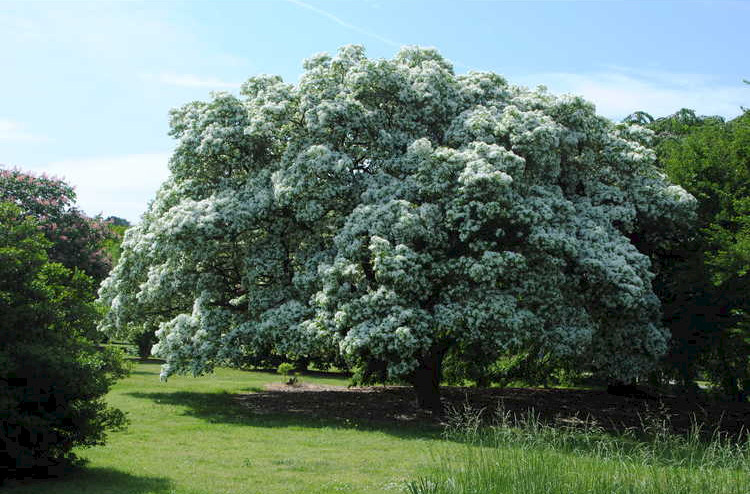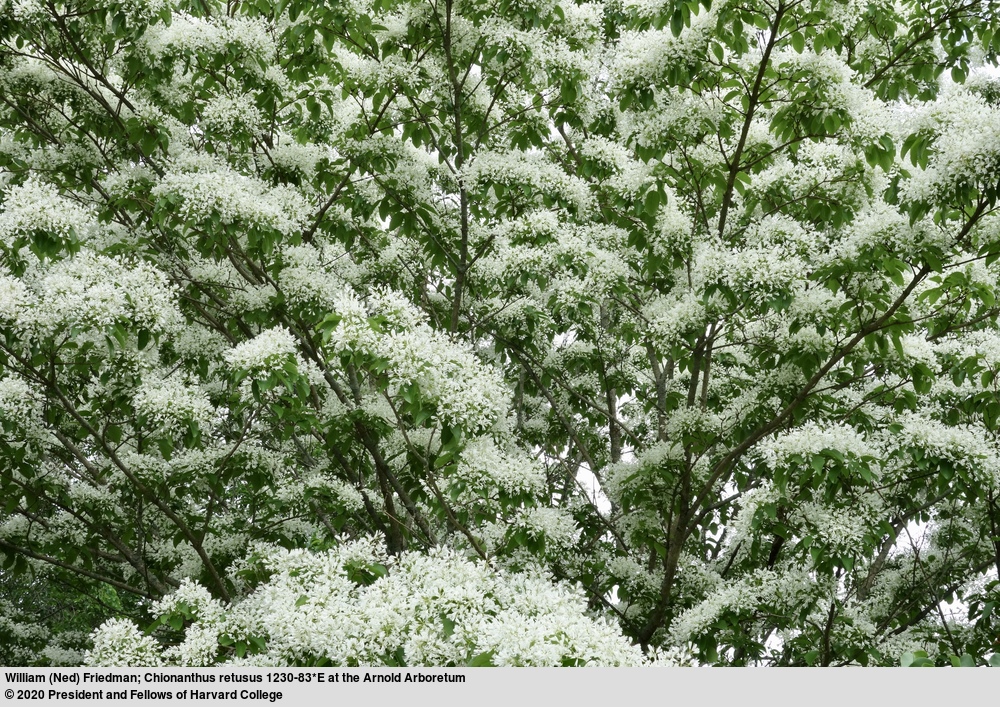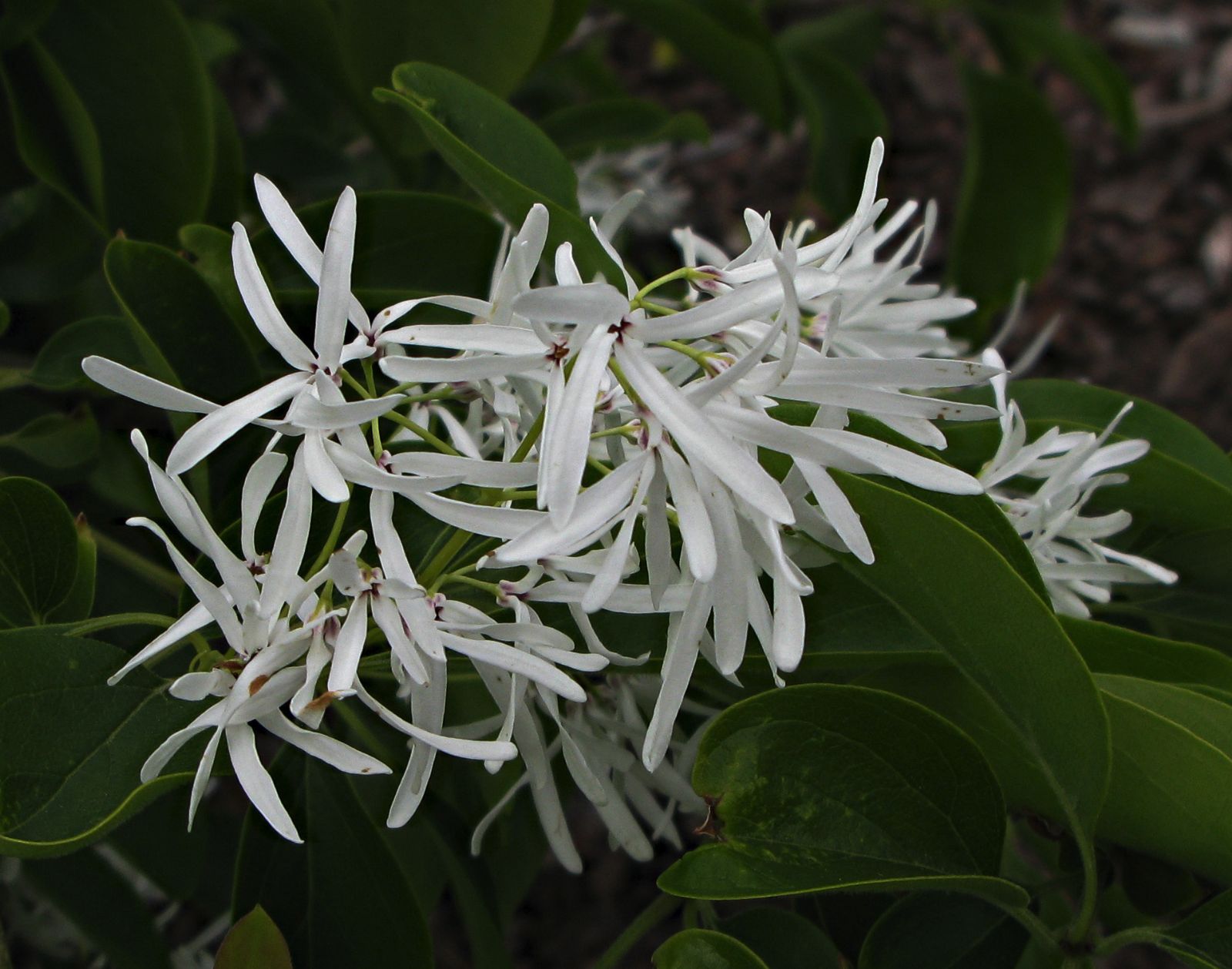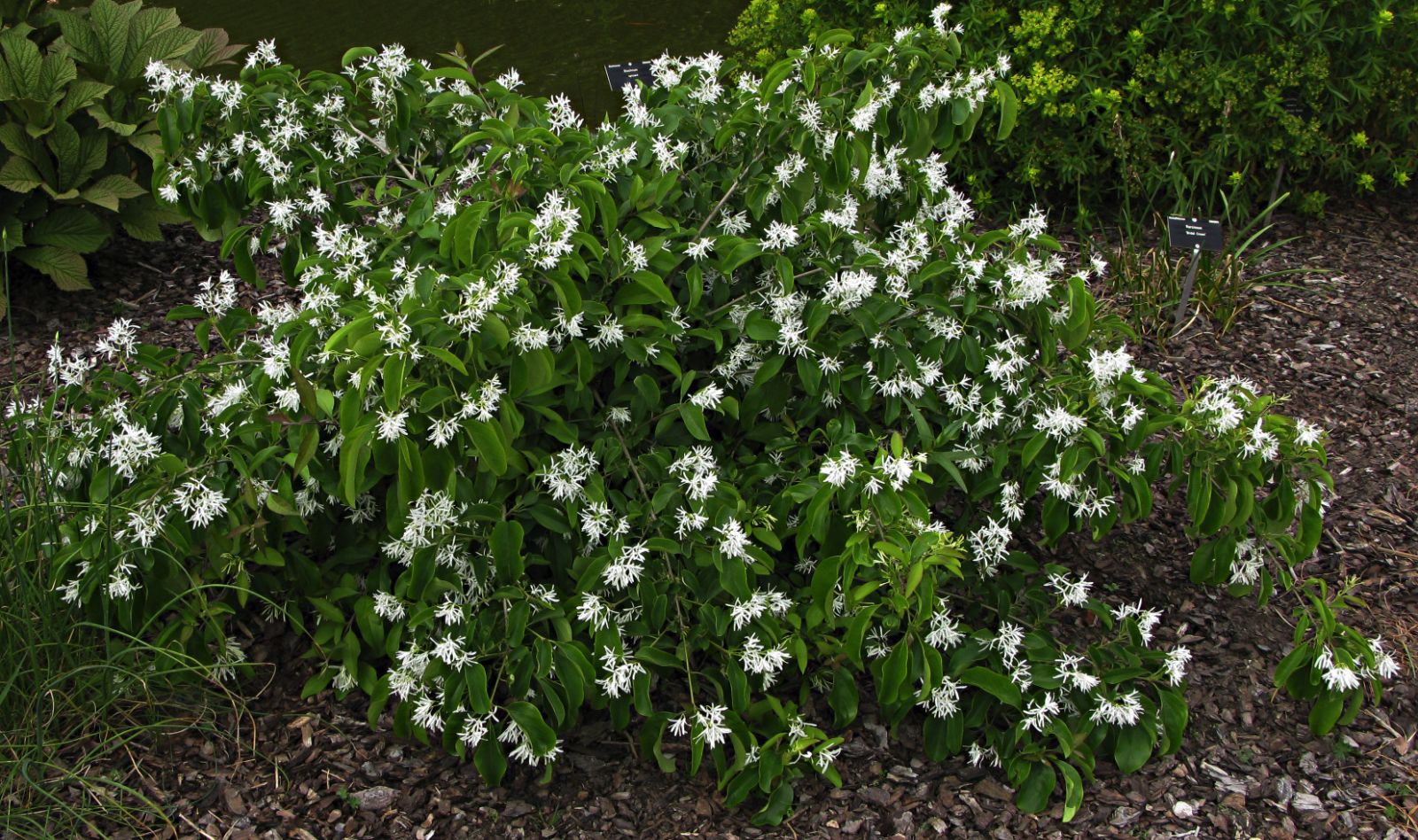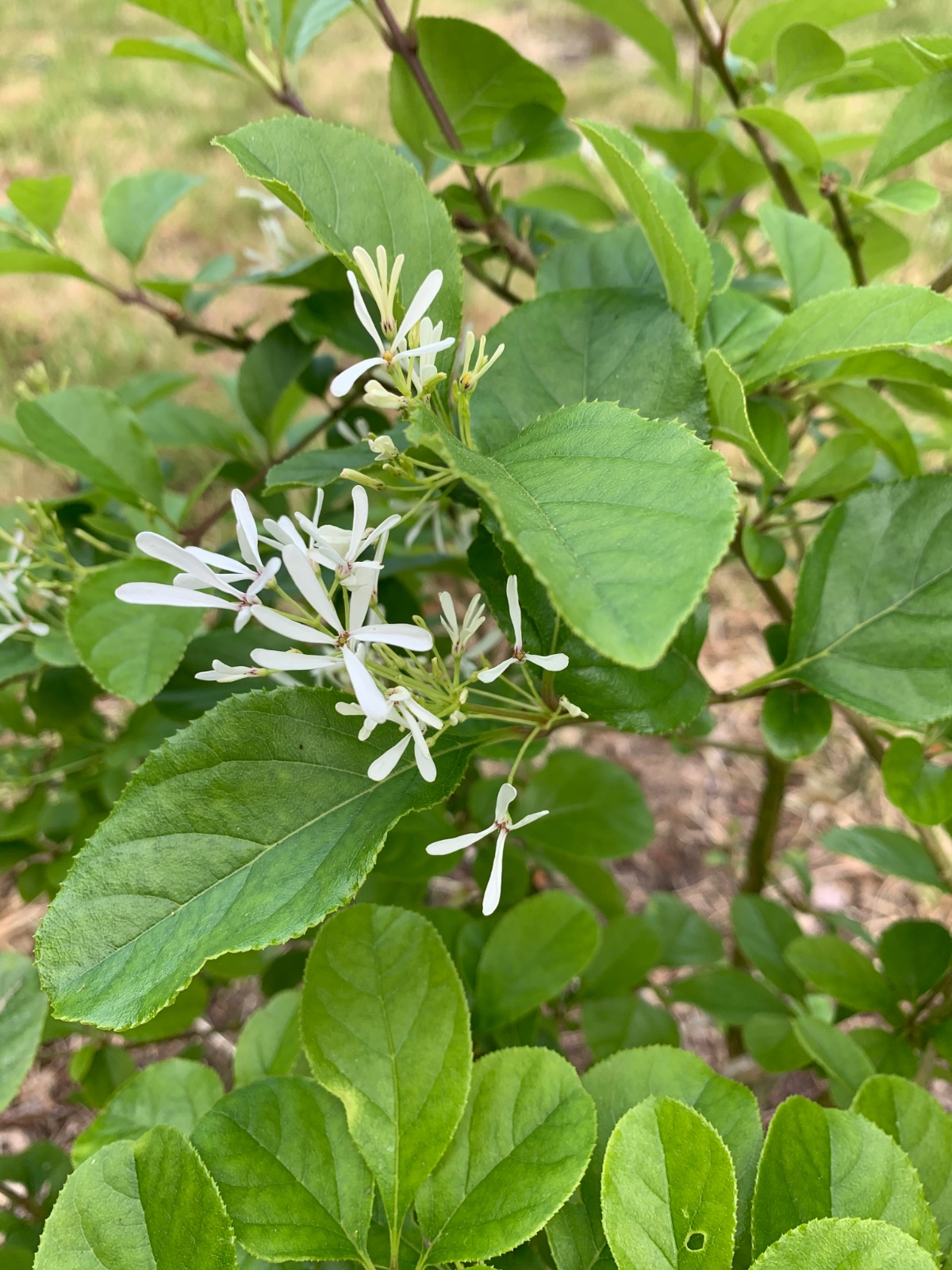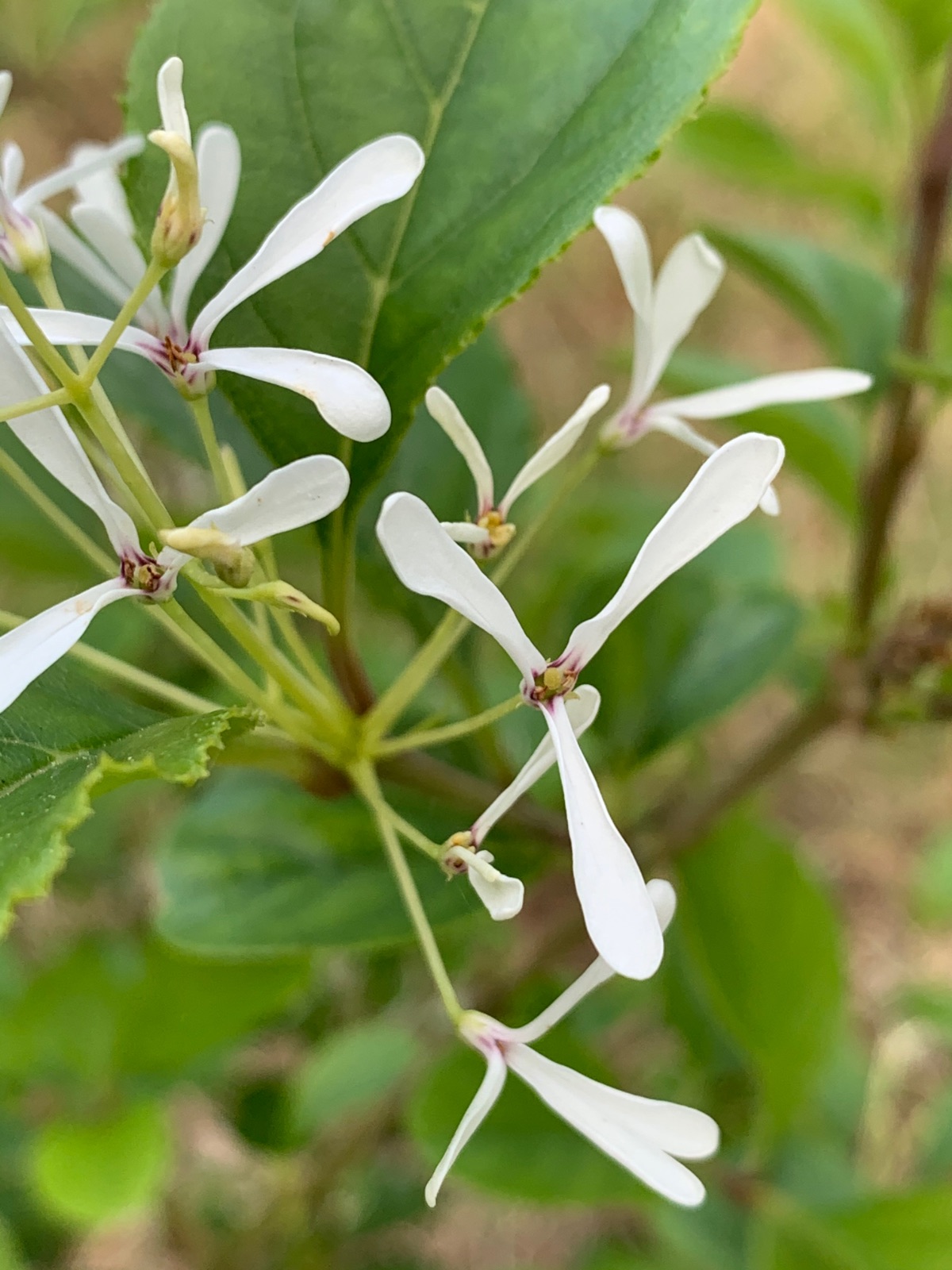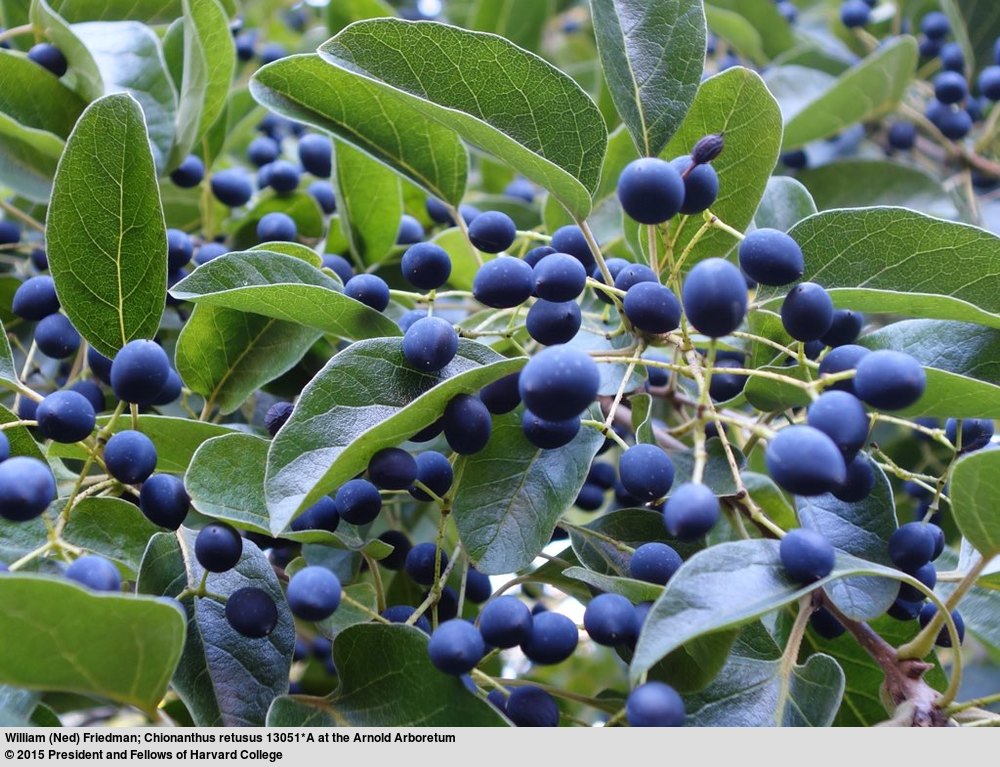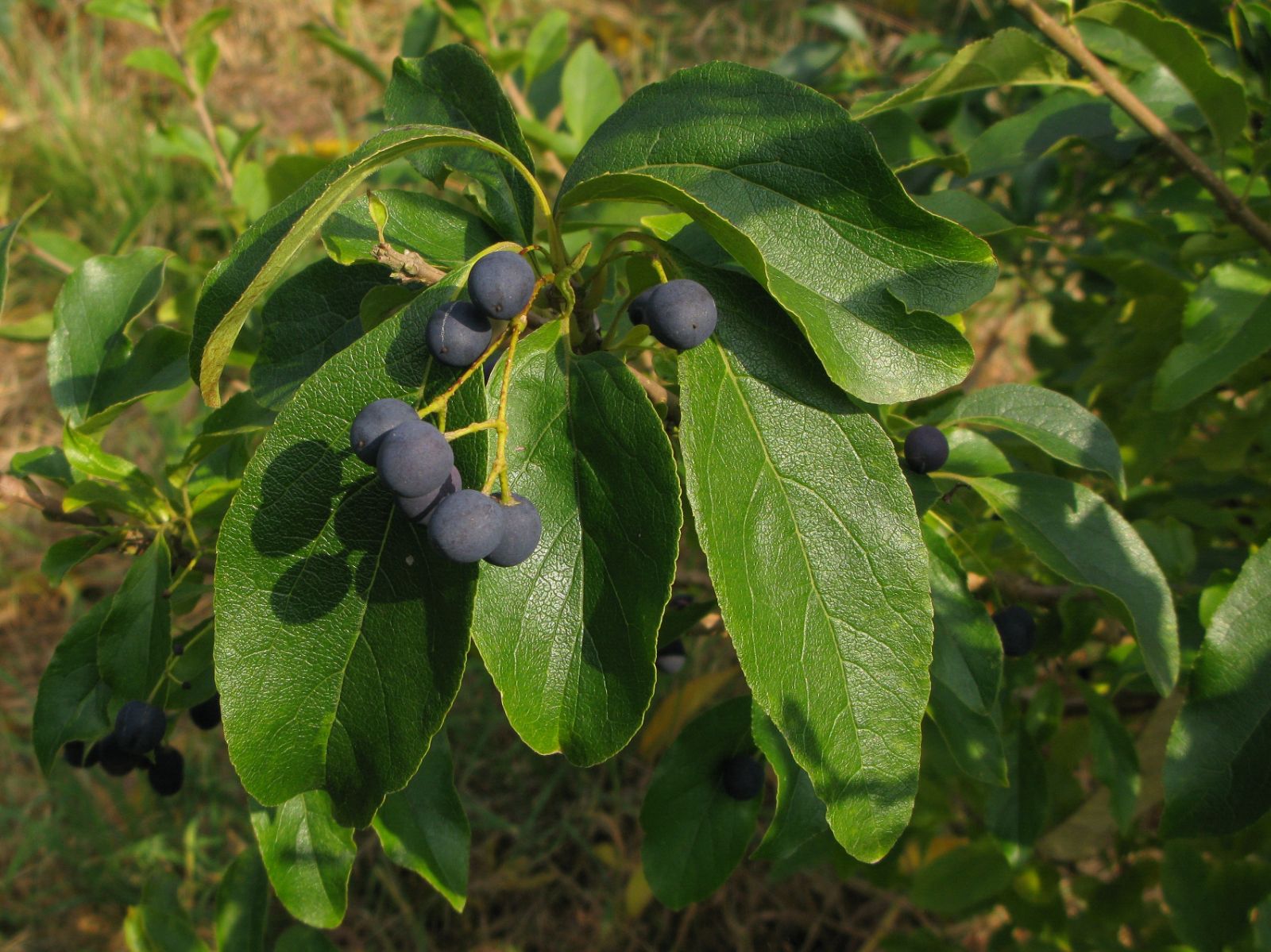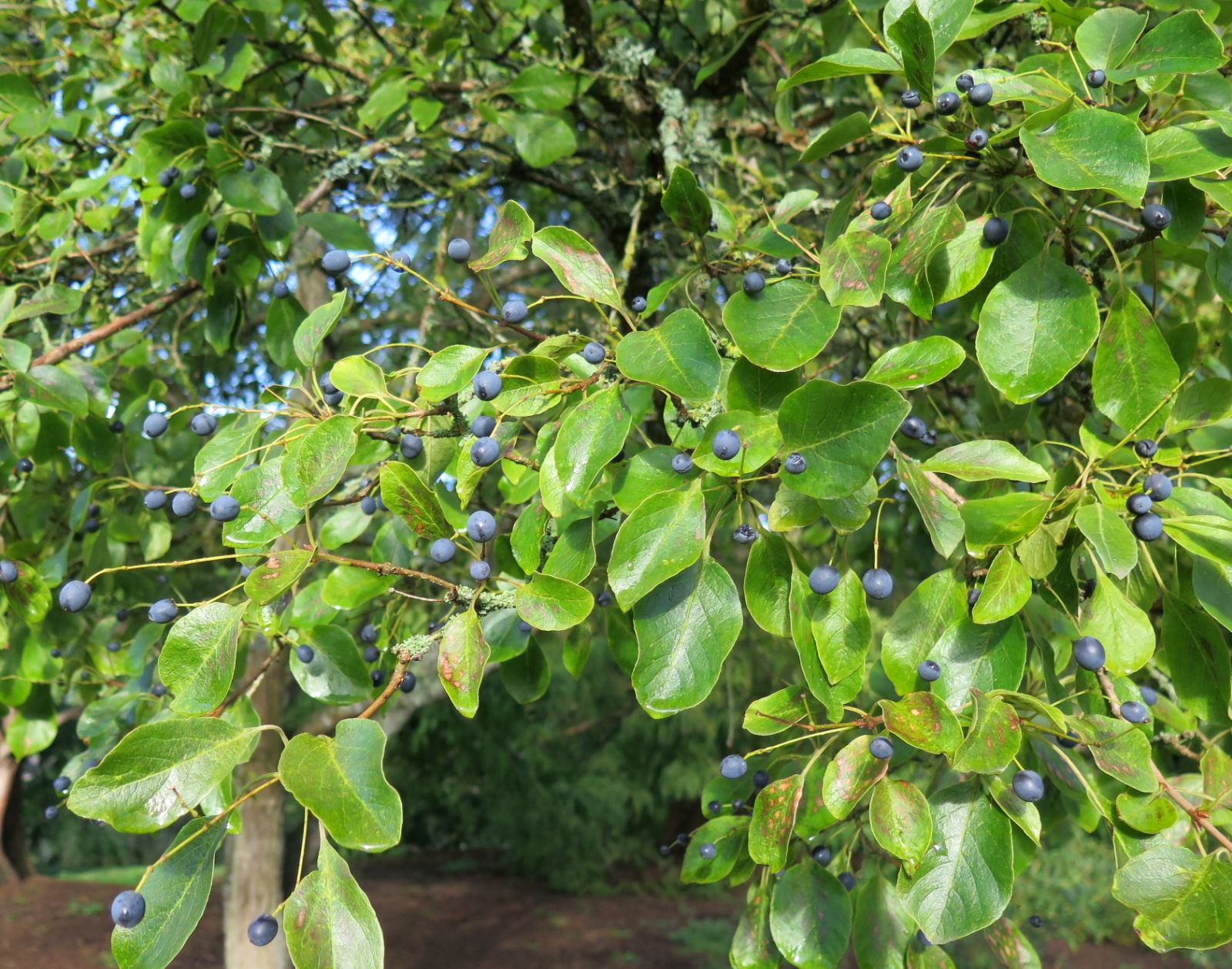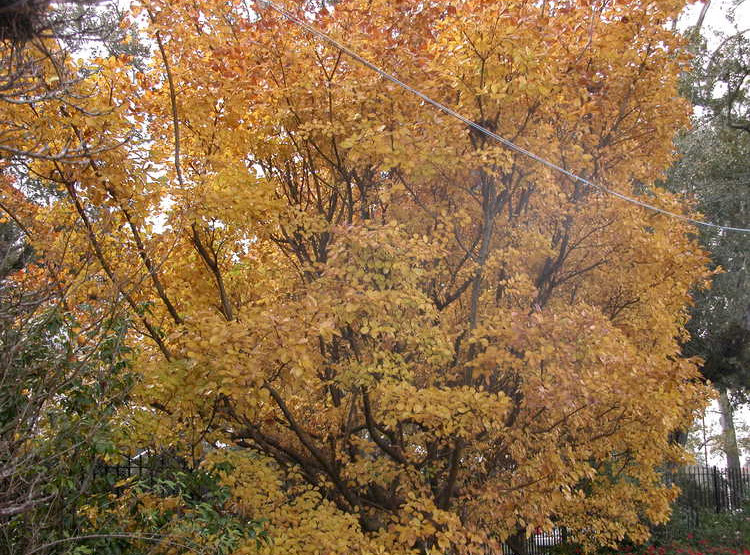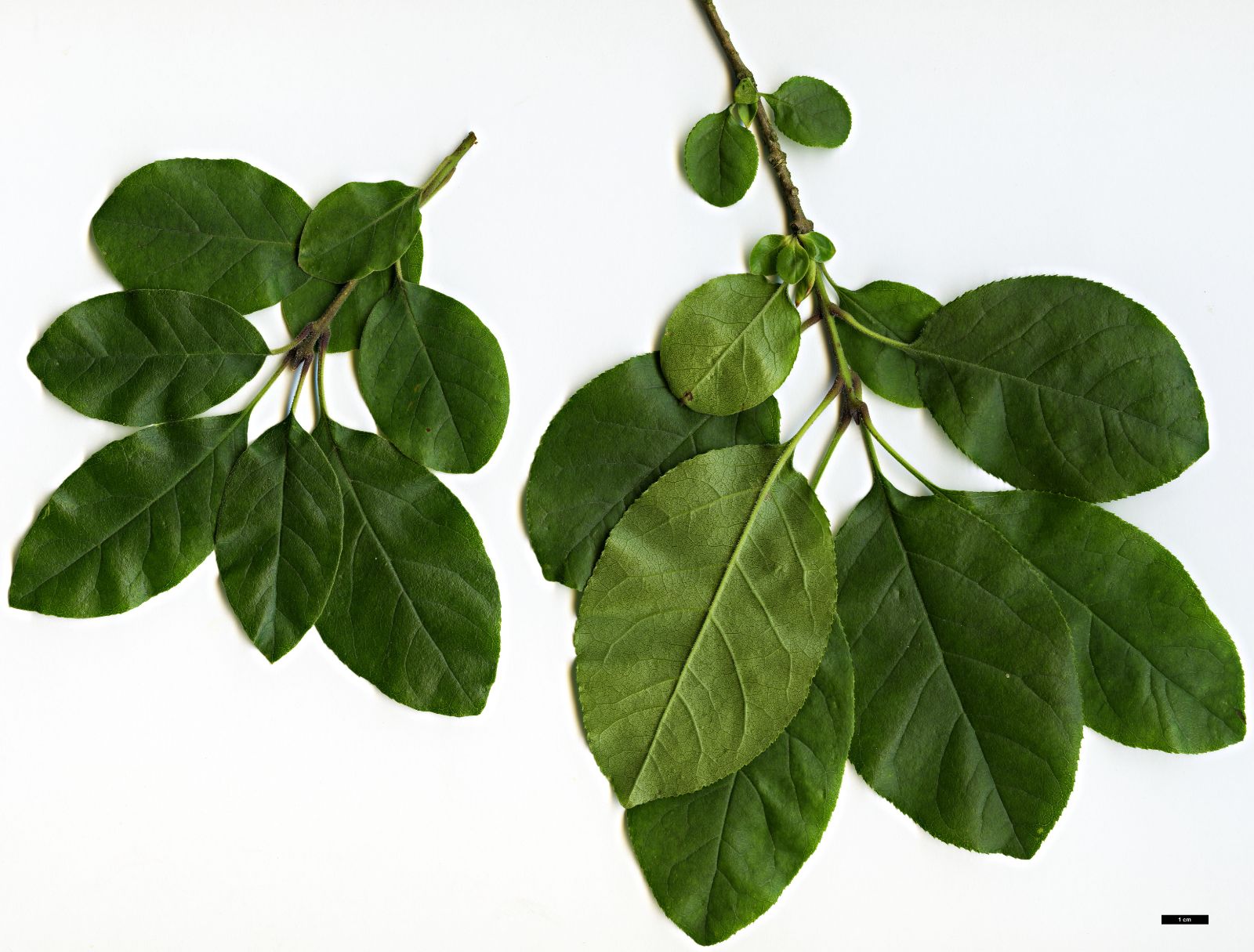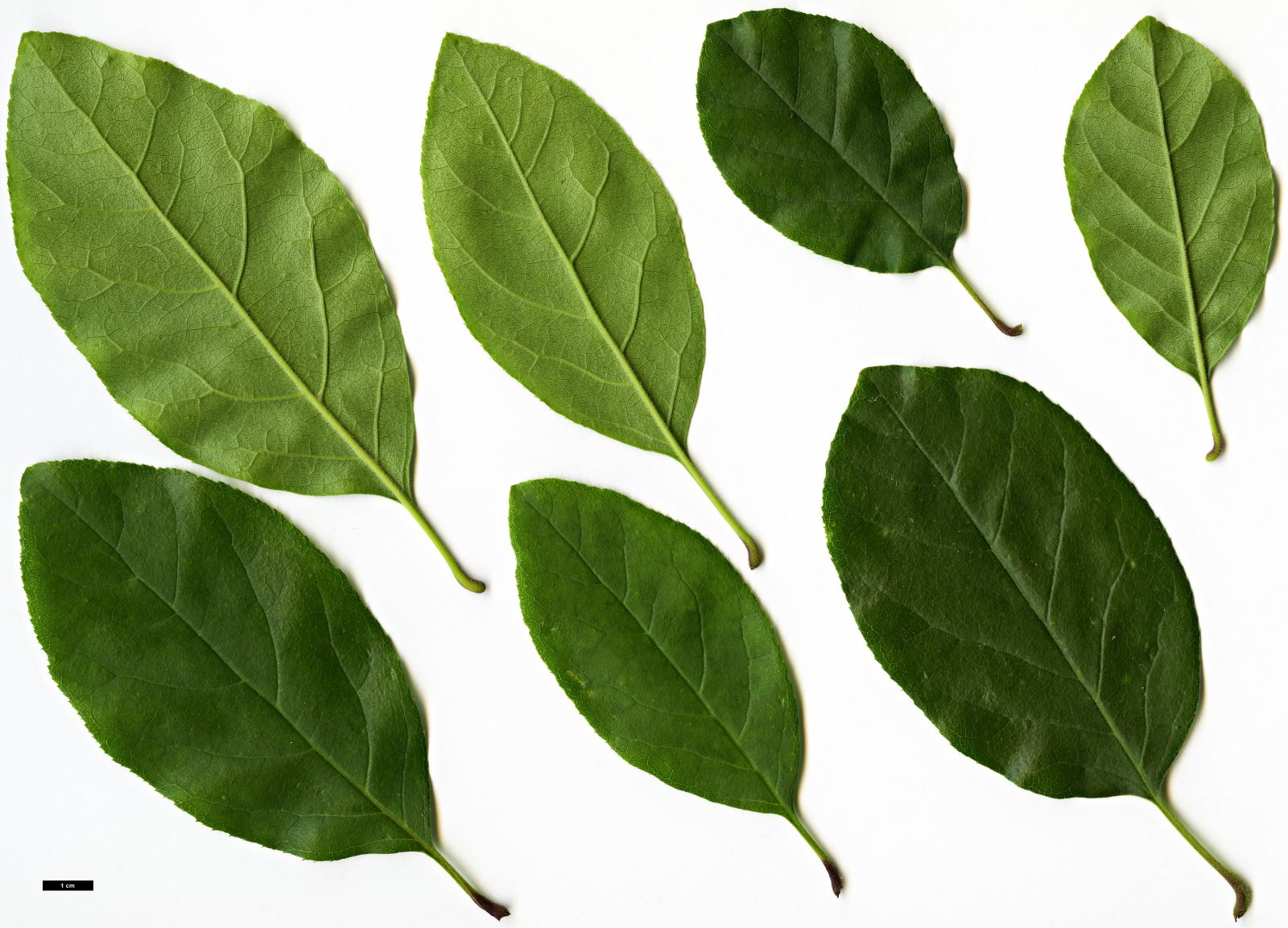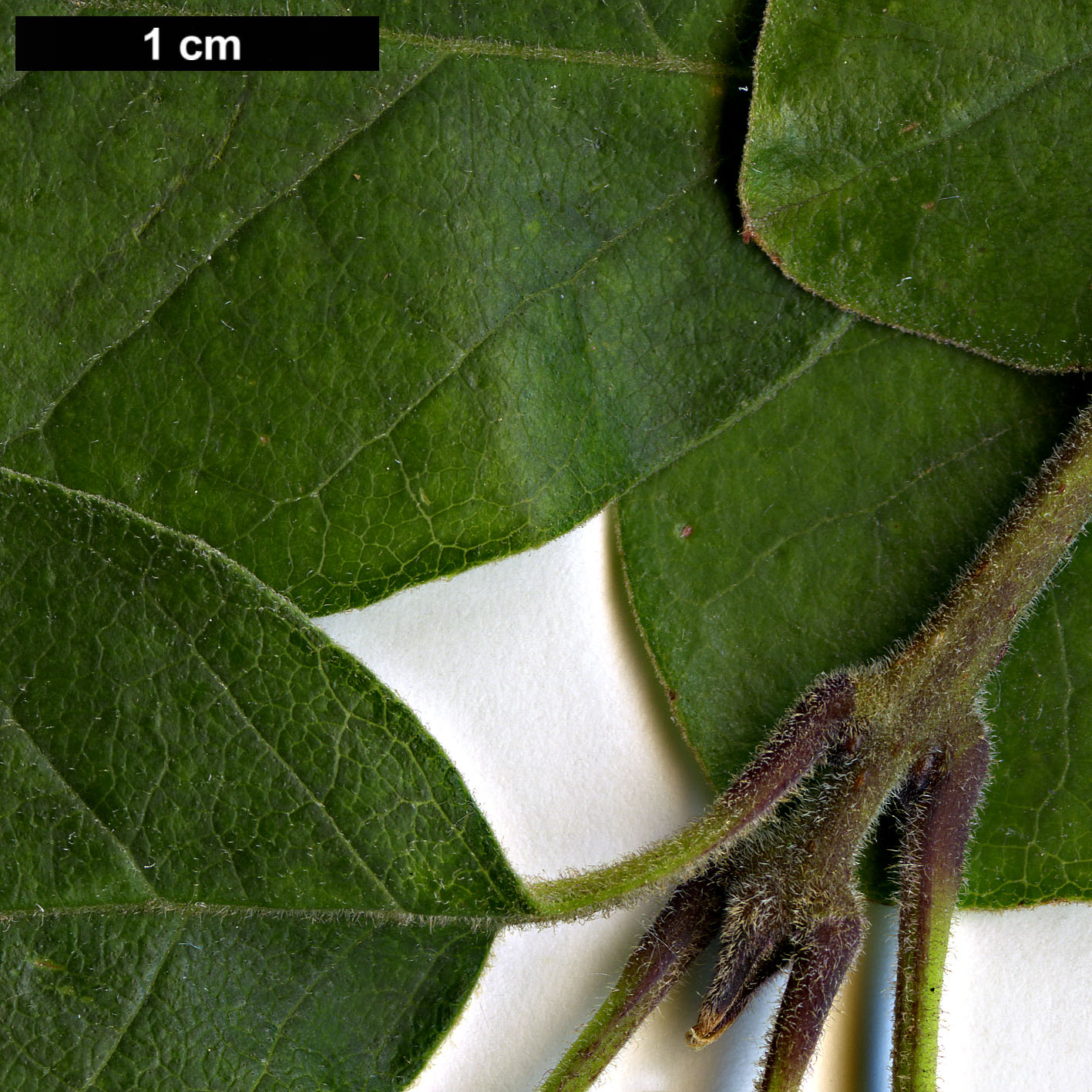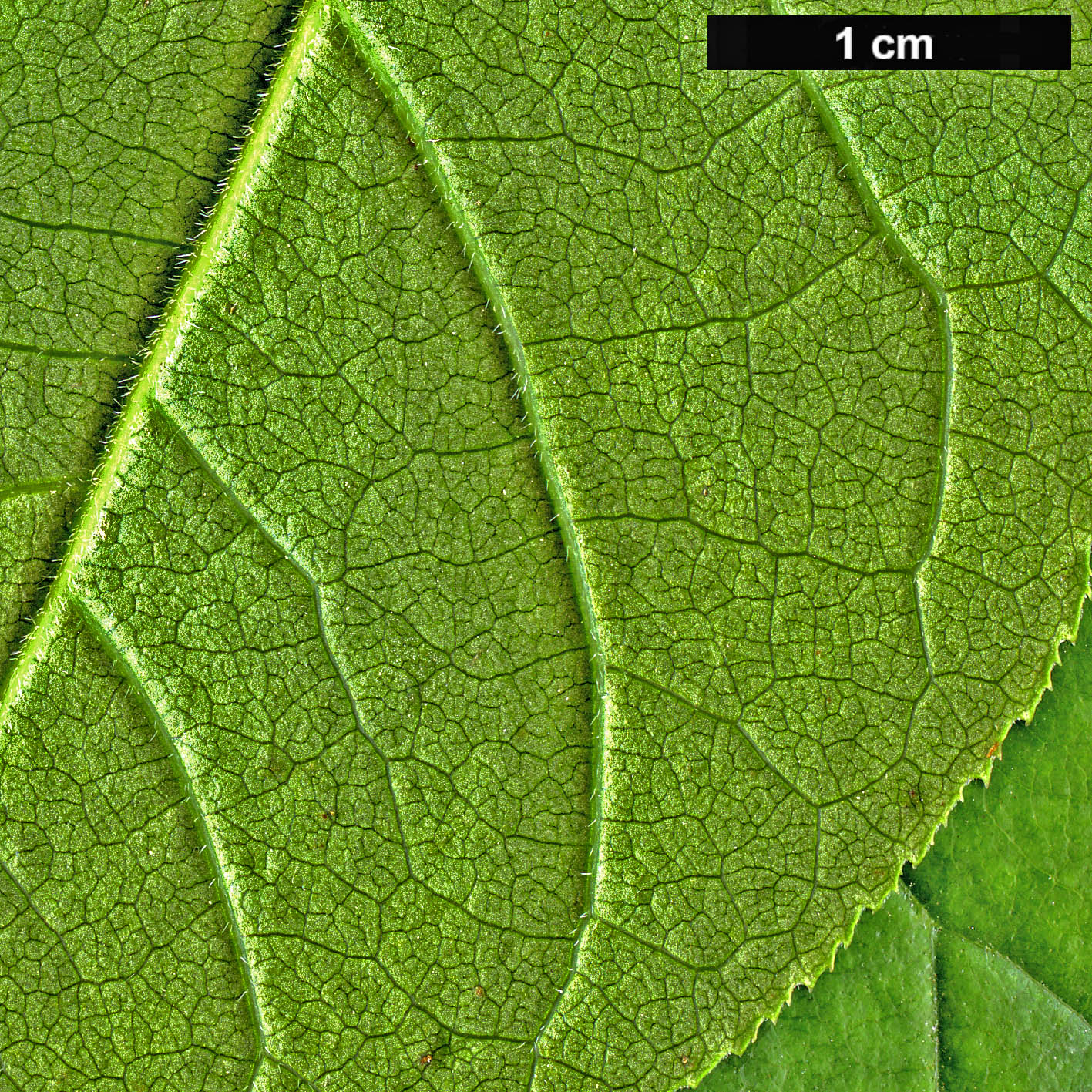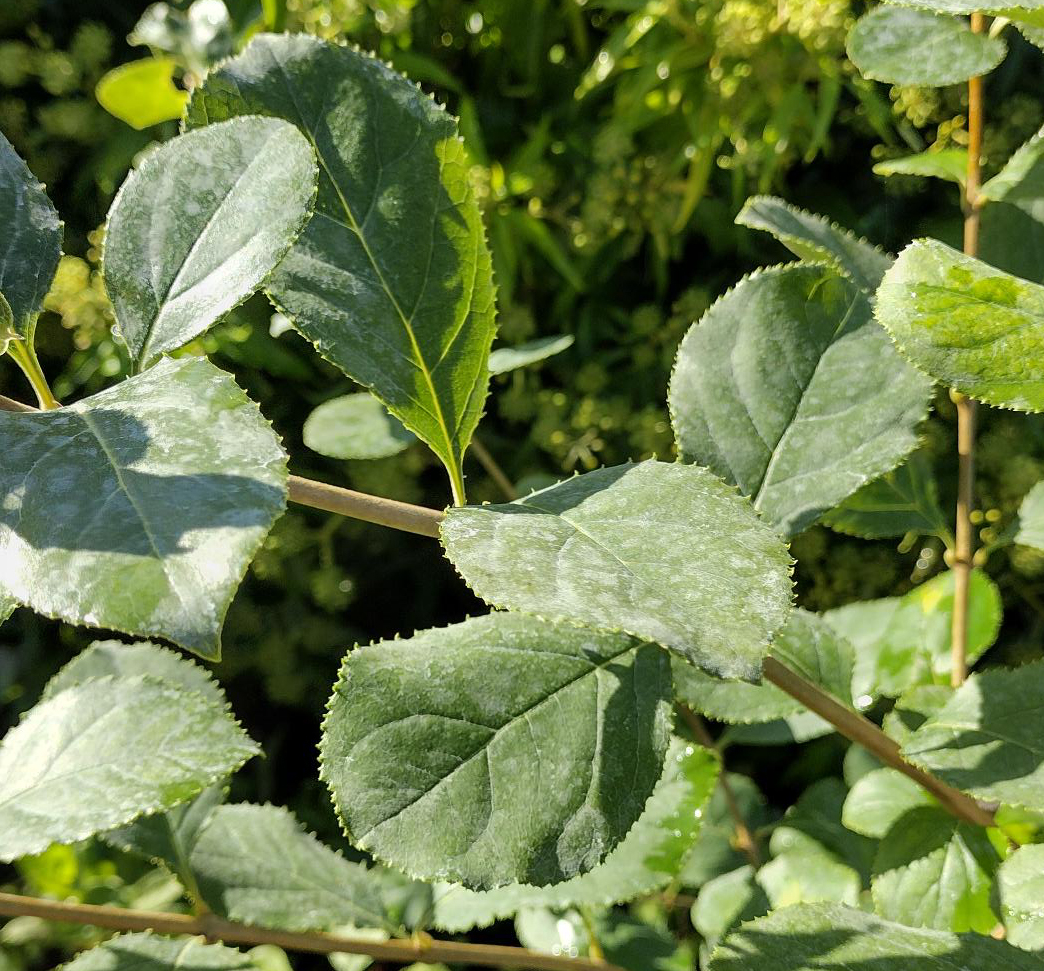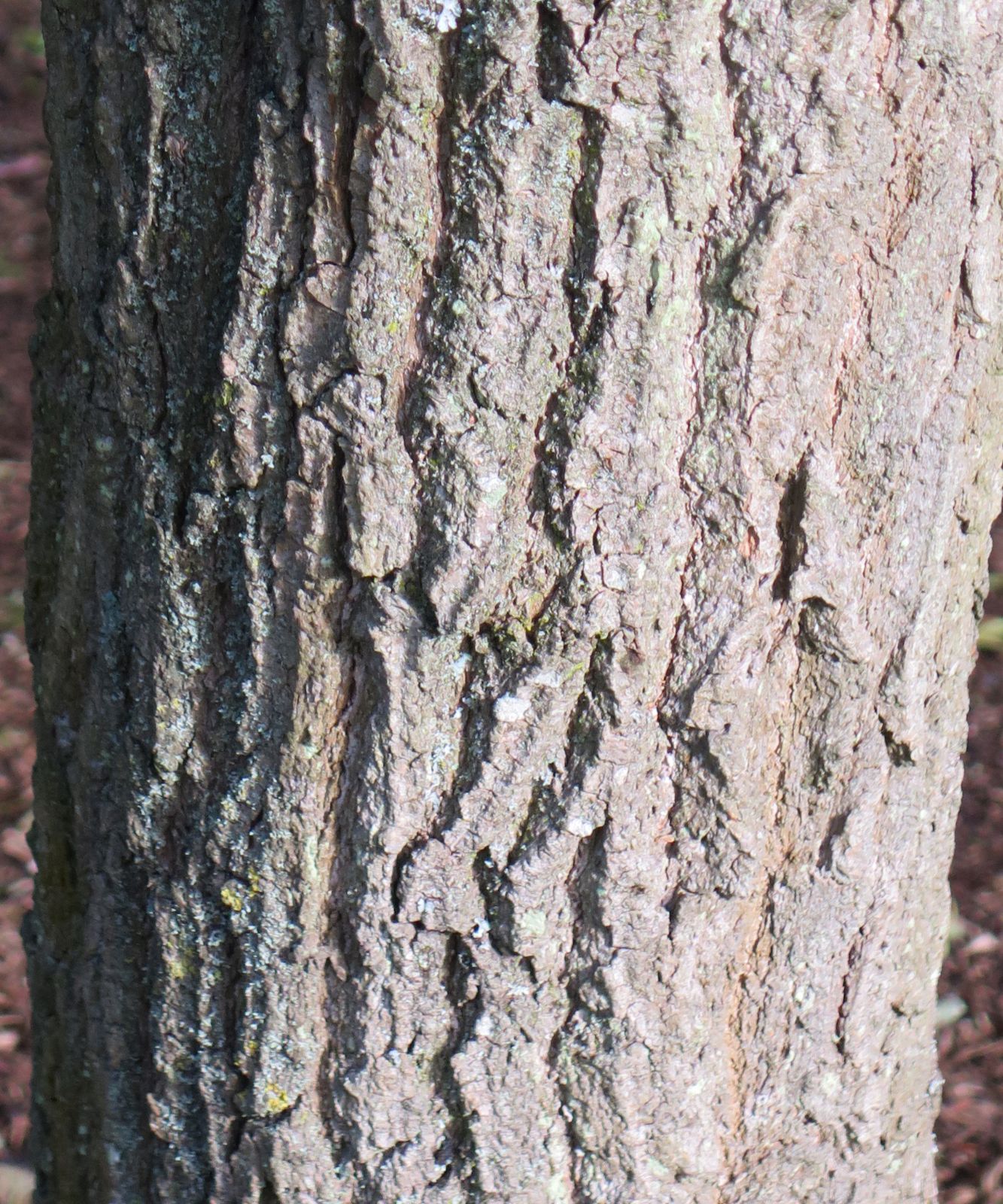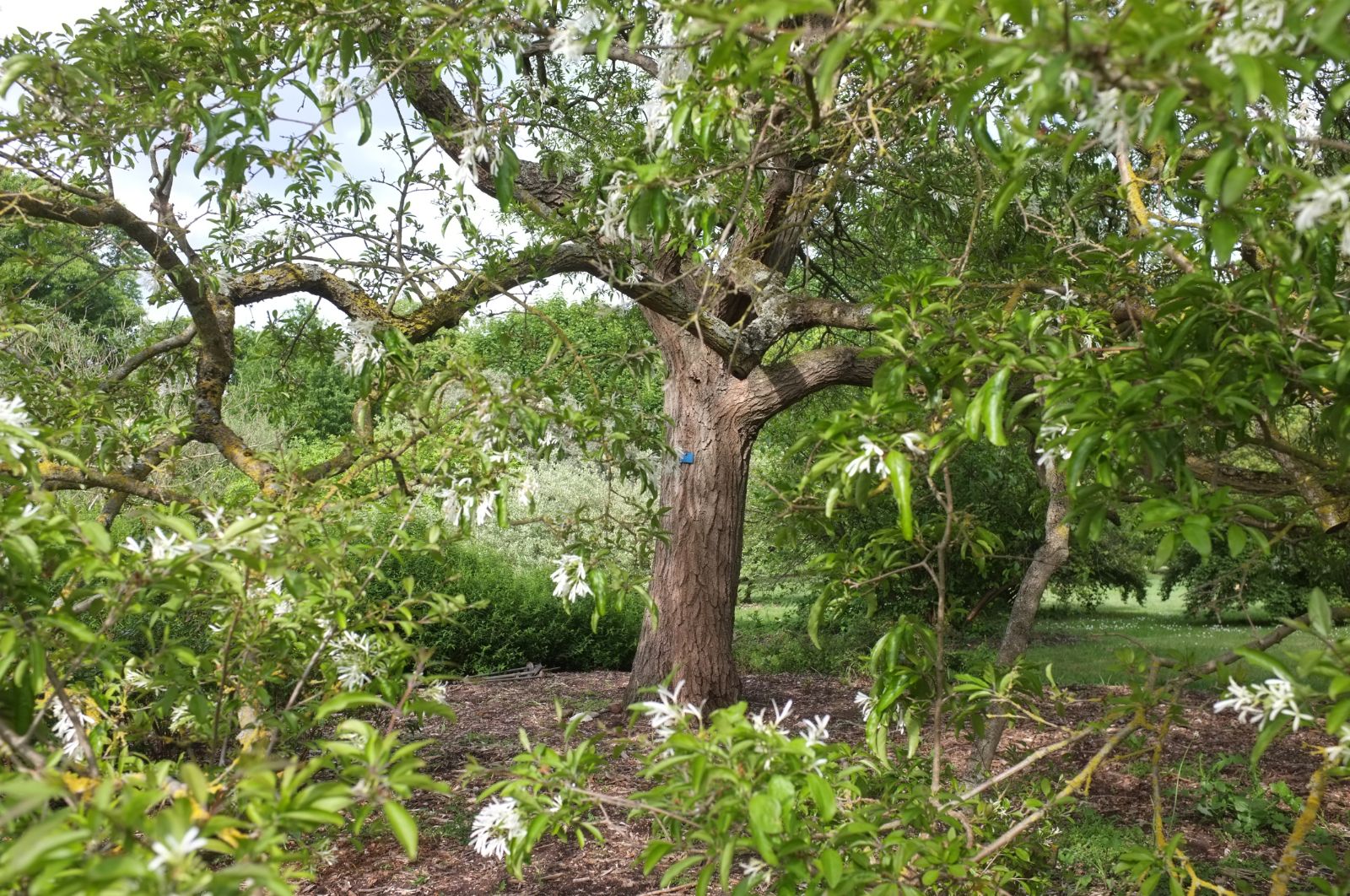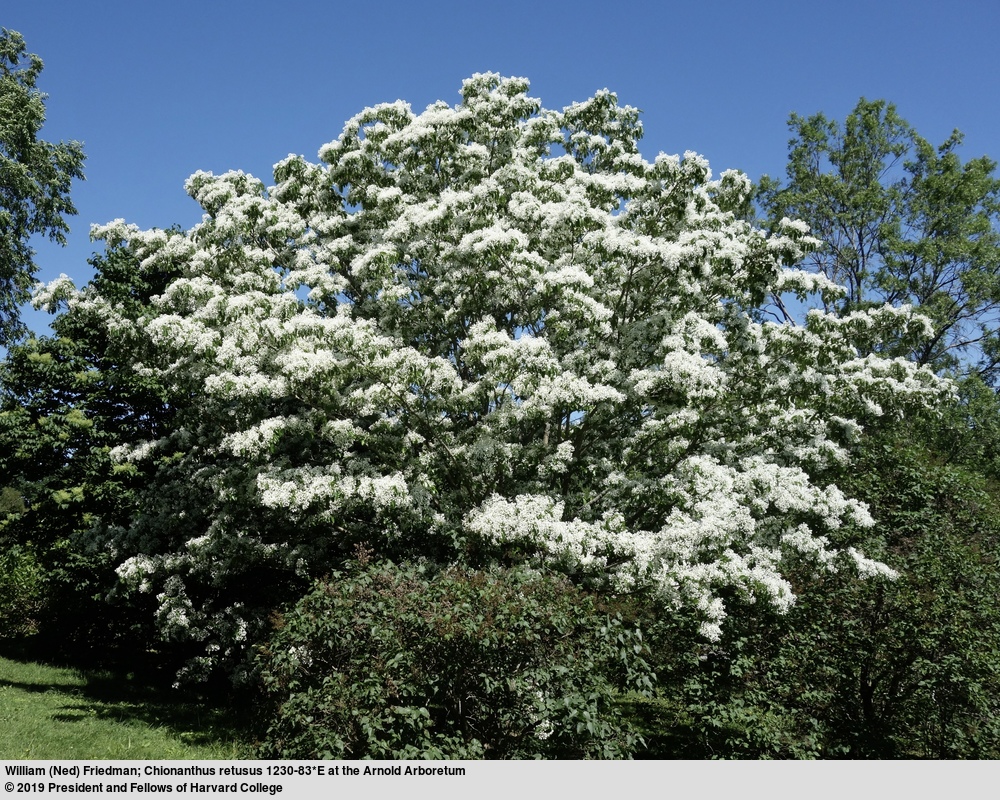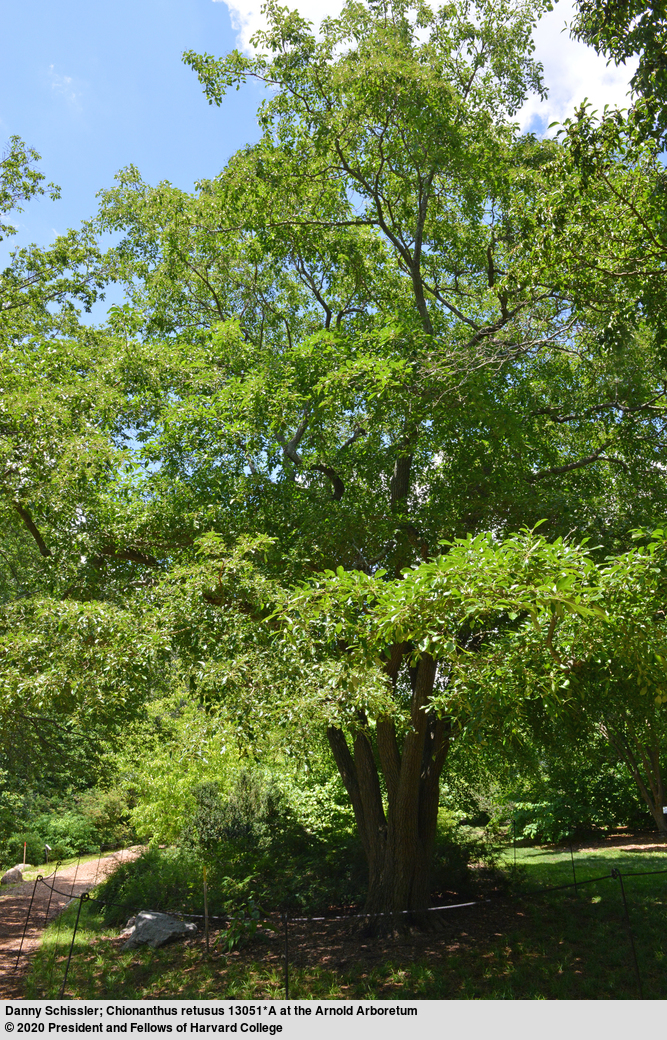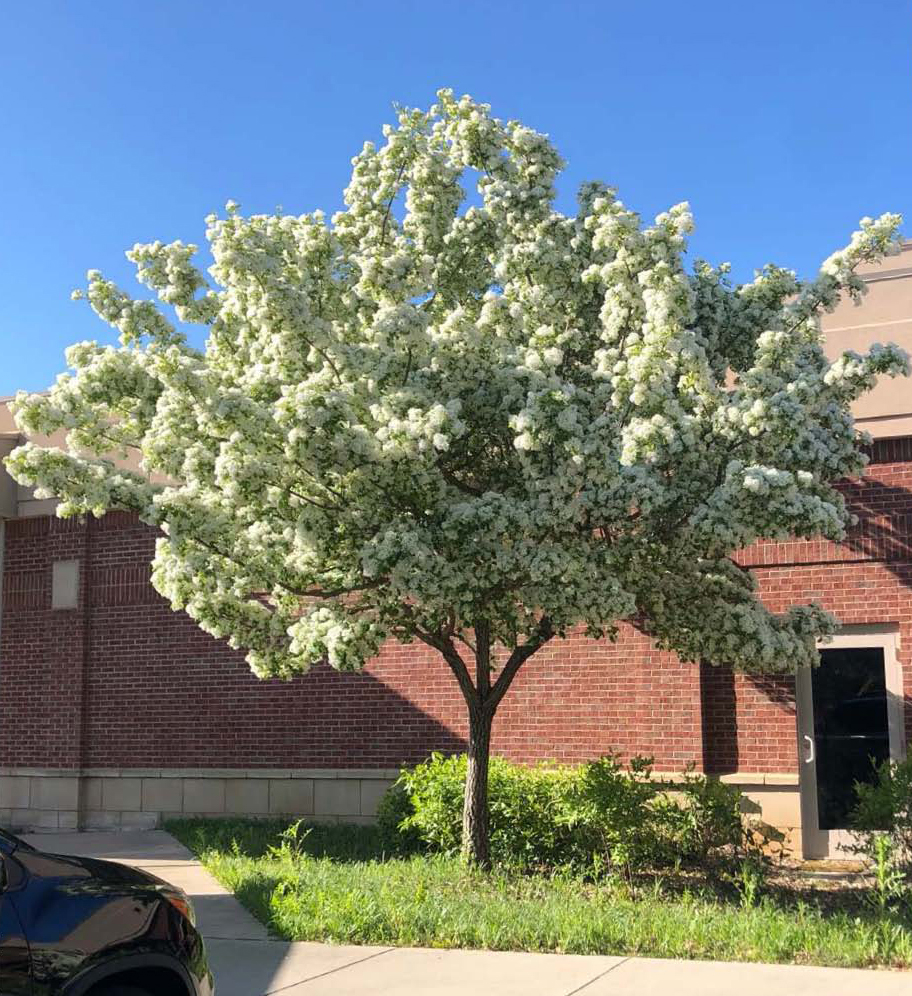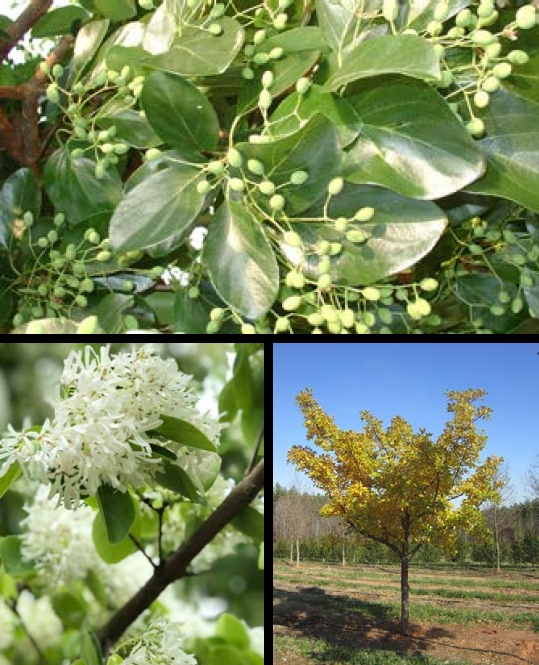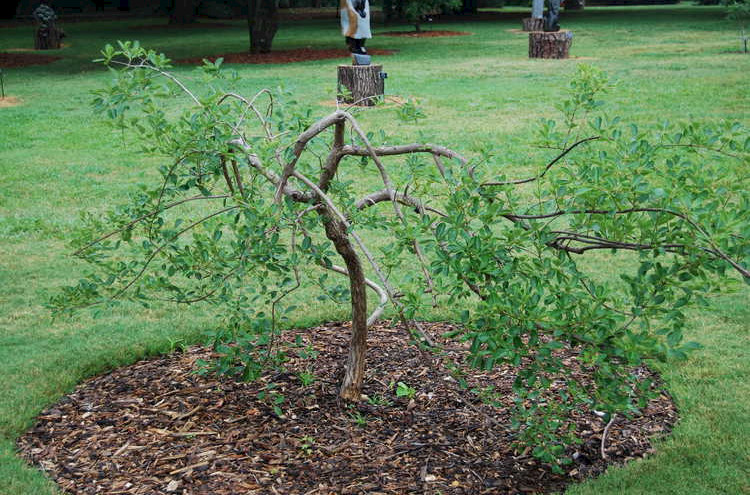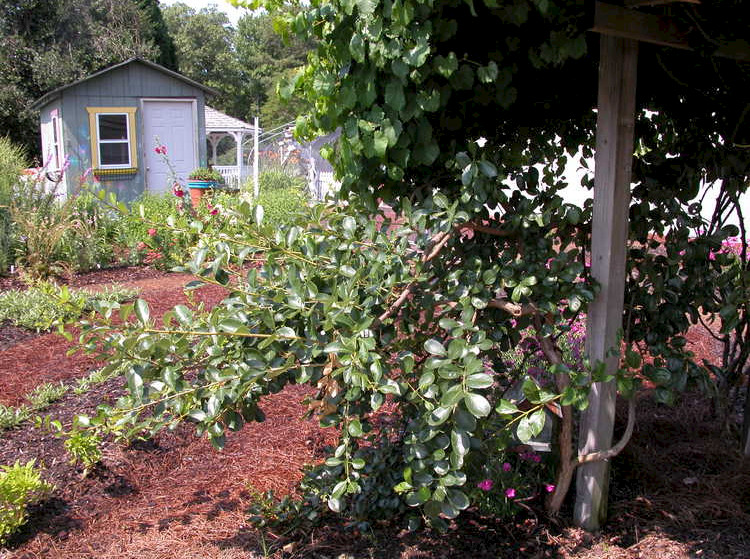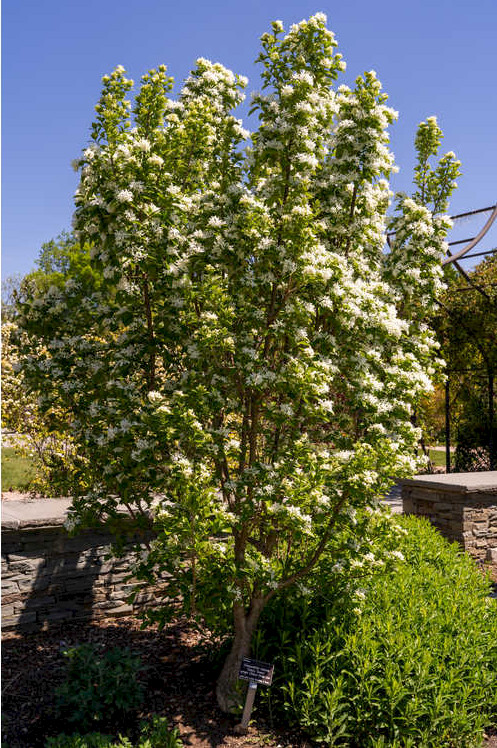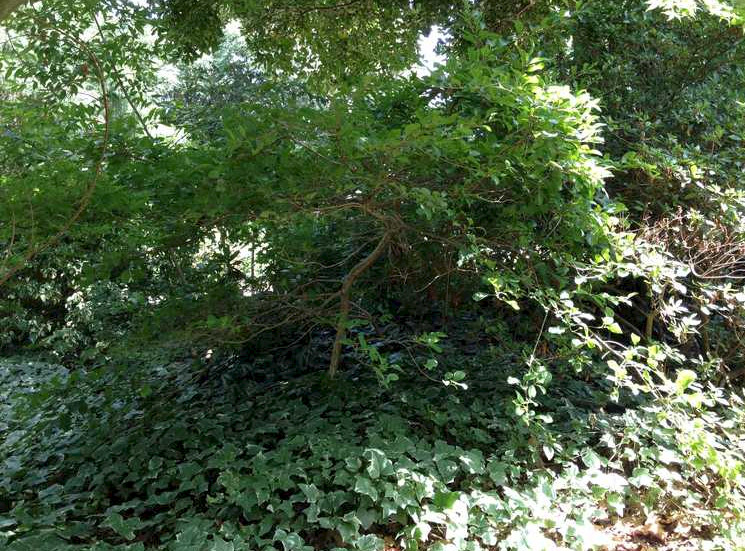Chionanthus retusus
Sponsor
Kindly sponsored by
a member of the International Dendrology Society
Credits
Julian Sutton (2022)
Recommended citation
Sutton, J. (2022), 'Chionanthus retusus' from the website Trees and Shrubs Online (treesandshrubsonline.
Genus
Common Names
- Chinese Fringetree
Synonyms
- Chionanthus retusus var. serrulatus (Hayata) Koidz.
- Chionanthus retusus f. coreanus (H.Lév.) M.Kim
Infraspecifics
Other taxa in genus
Large shrub or small (rarely medium) tree, to 20 m in the wild, deciduous. Branchlets terete, spreading, glabrous, or pubescent when young. Leaf blade 3–12 × 2–6.5 cm, usually somewhat leathery, quite variably shaped, oblong, elliptic or orbicular, sometimes ovate or obovate, with 3–4 slightly raised primary veins each side of midrib; margins entire, base rounded to cuneate, apex variable; upper surface villous along veins; lower surface villous, or glabrescent except on veins. Petiole 0.5–2 cm, densely covered with curly hairs. An androdioecious species, some plants having only male flowers, others with hermaphrodite flowers. Inflorescence a cymose panicle terminal on lateral shoots, 3–12 cm, glabrescent. Pedicel slender, 0.5–2 cm, glabrous. Calyx 1–3 mm; lobes narrowly deltate or lanceolate, 0.5–2.5 mm. Corolla white, lobes linear-oblanceolate, (1–)1.5–2.5 cm × 1.5–4 mm. Drupe ovoid, 1–1.5 × 0.6–1 cm, blue-black or black with a powdery bloom. Flowering March–June, fruiting June–November (China). (Chang, Qiu & Green 1996; Song, Oak & Hong 2016; Nicholson 1990).
Distribution China Fujian, Gansu, Guangdong, Hebei, Henan, Jiangxi, Shaanxi, Shanxi, Sichuan, Yunnan Japan Honshu (E of Nagoya), Tsushima Islands South Korea Taiwan
Habitat Mixed forests, thickets, riversides; 0–3000 m asl in China.
USDA Hardiness Zone 6-9
RHS Hardiness Rating H5
Conservation status Not evaluated (NE)
Like its North American counterpart Chionanthus virginicus, the East Asian C. retusus is potentially a most attractive large shrub or small tree, grown for its fleecy white inflorescences in late spring or summer, rather olive-like dark blue fruits (on hermaphrodite plants), its attractive, sometimes peeling, grey-brown bark, and yellow autumn colour. Although deciduous, in milder areas such as the American Southeast it may hold its leaves into the New Year (Dirr & Warren 2019). Quite hardy, it performs best in continental climates and is a more popular garden plant in eastern North America than in Europe, although long grown in Japan and China.
By accident of taxonomic and garden history, C. retusus will inevitably be thought of in comparison with C. virginicus, which has been known and grown far longer in our area. In flower C. retusus is distinguished by its more erect inflorescences being terminal on the current year’s growth, rather than axillary on last year’s wood. It tends to flower a little later in gardens (Nicholson 1990), typically June in the Boston, MA area but as early as March in Southern California (Jacobson 1996). In contrast to the functional dioecy of C. virginicus, C. retusus is androdioecious (Song, Oak & Hong 2016). Some trees have functionally male flowers, with a visible but sterile gynoecium; others have hermaphrodite flowers. Most floral organs (including petals – important to gardeners) are larger in the hermaphrodites. The flowers are scented, with a detectable odour difference between males and hermaphrodites (Song & Hong 2020). Dirr & Warren (2019) observe that in North America the fruits persist longer than those of C. virginicus, perhaps reflecting birds’ preferences.
Leaf variation in this species is bewildering (Nicholson 1990). As a broad generalization, its leaves tend to be smaller, more leathery, and proportionately broader than those of C. virginicus, but there is great diversity in shape, size and apex form, sometimes even within leaves on the same shoot. Much has been made of the leaf margin, coarsely to finely serrate or entire. The name C. retusus var. serrulatus (Hayata) Koidz., first used for a plant from Taiwan, is still sometimes seen attached to serrate-leaved specimens, although rarely accepted by contemporary botanists. Serrate margins can certainly be a juvenile feature: Dirr (2009) noted that every seedling in a batch raised from a tree with entire margins at the Arnold Arboretum had serrate margins when young. However, having studied numerous herbarium specimens from across the species’ wild range, Nicholson (1990) is adamant that mature specimens sometimes have serrate leaves. A lanceolate-leaved variant, f. coreanus (H.Lév.) M.Kim has been described from Jeju (Quelpart) Island, S Korea, but is rarely recognized today.
A rather slow-growing plant, young specimens are likely to be multistemmed shrubs. Some apparently form trees more readily than others, but there seems to be no real evidence that this is correlated with provenance.
The Chinese Fringetree reached Europe in the mid-19th century, collected from a garden in Fuzhou, Fujian Province, by Robert Fortune who noted that it was probably native further north, and that it was propagated locally by grafting onto Osmanthus fragrans (Lindley & Paxton 1853). Bean (1976) gives the date as 1845, meaning that this was during Fortune’s first visit to China, although in naming the species from this cultivated stock Lindley & Paxton (1853) implied a rather later but less plausible date. Either way, Bean (1976) suggests that it did not become established in Europe until an 1879 collection by Charles Maries working for the Veitch Nursery, whether from China or Japanese cultivation is unclear. It entered North American cultivation no later than 1901. There has been no shortage of further introductions, although none stand out as particularly significant. Ernest Wilson collected specimens from Sichuan in 1907 and 1908 under W 1057 (Sargent 1916); seed may have been gathered in September 1908. Both George Forrest and Joseph Rock encountered the species in Yunnan (Nicholson 1990), and also may have collected. More recent introductions include BBJMT 284 (Honshu 2005), BCJMMT 304 (Honshu 2007), NACPEC 02042 (Shanxi 2002) and SICH 2400A (Sichuan 2003). Korean material is in cultivation, usually without collectors’ references, and nurserymen from the American South have made horticulturally important introductions from Japanese cultivation in recent years (Dirr 2009). Cultivars have been selected for growth form, free flowering and ease of propagation. In addition to those listed, the Chinese ‘Chunxue’ (early flowering, flowers in first year from grafting, drought and cold tolerant in trials – Hatch 2021) has apparently not yet been distributed in our area.
Use of C. retusus in gardens parallels that of C. virginicus, but it is perhaps more tolerant of heat, drought and full sun (Dirr & Warren 2019) as well as undoubtedly being less hardy. Scarce in North America until the 1960s (Jacobson 1996), it is becoming quite widely grown in specialist collections and beyond from Massachusetts south to Florida, in less cold parts of the Midwest and on the Pacific seaboard. Far less common in Europe, cold-hardiness limits its use in Central Europe, but it is sometimes seen in Western Europe, especially where summer temperatures are higher; flowering and fruiting are rarely as impressive as in North America.
Old specimens forming really impressive trees are few. One dating from 1922 at RBG Kew makes a shapely single-trunked specimen (10 m × 162 cm, 2022), while a tree at Highdown, West Sussex (10 m × 252 cm, 2017) makes a mass of erect stems from a very short bole (The Tree Register 2022). Perhaps the most impressive and certainly the most celebrated specimen in our area is a single-trunked 10 m specimen with vase-shaped crown at the Arnold Arboretum, MA, from seed received in 1901 from the Imperial Botanic Gardens, Tokyo (Nicholson 1990; Arnold Arboretum 2022); it has been propagated vegetatively as ‘Arnold Select’. Other selections have been made, mainly for crown form and good flowering, mostly in North America. A few of these are becoming available in the European trade.
As in C. virginicus, seed shows double dormancy, autumn-sown seed germinating in its second spring. Cuttings are not easy, although some cultivars have been selected for comparitive ease of rooting. Grafting (probably onto seed-raised C. retusus or C. virginicus) is sometimes practiced, while layering is another possibility (Bean 1976).
'Arnold's Pride'
Rounded to vase-shaped crown in the early years, developing a pronounced clear trunk; freely flowering and fruiting (Nichols Nursery 2022; Broken Arrow Nursery 2022). Claimed as suitable for street plantings (Dirr & Warren 2019). Propagated vegetatively from the celebrated early 20th century specimen at the Arnold Arboretum (see above).
'Ashford'
Upright habit, golden brown exfoliating bark. Selected before 2019 by Rich Hesselein, Pleasant Run Nursery, NJ (Dirr & Warren 2019).
'China Snow'
A foliage selection: very thick textured, glossy, dark green, rounded leaves; low-branching, with a very dense rounded crown – ‘One could bounce a quarter off the impenetrable foliage’ (Dirr & Warren 2019). Named before 2009 by Don Shadow, TN, and currently quite common in the North American trade (Dirr 2009, 2021; Avent 2021). Few nursery listings mention fruit.
'Confucius'
Large tree form with rounded canopy; foliage shiny dark green, like ‘Arnold’s Pride’ in shape; male. Selected before 2019 at the US National Arboretum (Dirr & Warren 2019).
'CRN10'
Synonyms / alternative names
Chionanthus retusus SPIRIT™
Leathery, dark green foliage remaining attractive through the summer; exfoliating bark; a hermaphrodite, fruiting copiously. Selected before 2021 by Select Trees, Georgia; marketed for tough urban situations, and sold on its own roots (Select Trees 2022;(Dirr & Warren 2019).
'Norfolk Weeper'
Weeping habit combined with abundandant flowering, typically reaching 1.5 m height in 10 years. Grown at the Norfolk Botanical Garden, VA, before 2007 and probably originating there (Nichols Nursery 2022; JC Raulston Arboretum 2022). Commercially available on both sides of the Atlantic.
'Tokyo Tower'
Synonyms / alternative names
Chionanthus retusus 'Ivory Tower'
A strikingly narrow-crowned form with foliage close to ‘China Snow’ and exfoliating bark, brought to the United States from Japan by Harald Neubauer of Hidden Hollow Nursery, TN, before 2006 (Missouri Botanical Garden 2022; Dirr 2009; Dirr & Warren 2019). In Michael Dirr’s Georgia garden it produced few flowers until its sixth year, and then mainly at the top. Dirr & Warren (2019) note ‘yet to observe fruit’, so perhaps a male. It is unclear whether ‘Tokyo Tower’ or ‘Ivory Tower’ was the first published name, or indeed whether an earlier Japanese cultivar name exists, but ‘Tokyo Tower’ is now the dominant name in Western horticulture.
'Yadkin Creeper'
A low, spreading form with typical flowers and leaves, which has reached 1.8 m height and 2.4 m spread in 15 years. Discovered 2003 at Yadkin Valley Nursery, NC by Todd Lasseigne and Jon Roethling of the JC Raulston Arboretum (Nichols Nursery 2022). Commercially available on both sides of the Atlantic.

